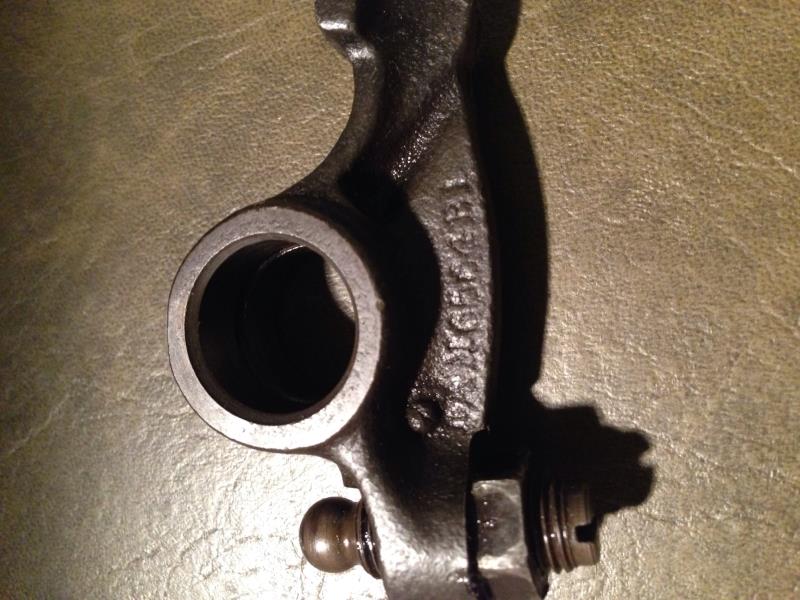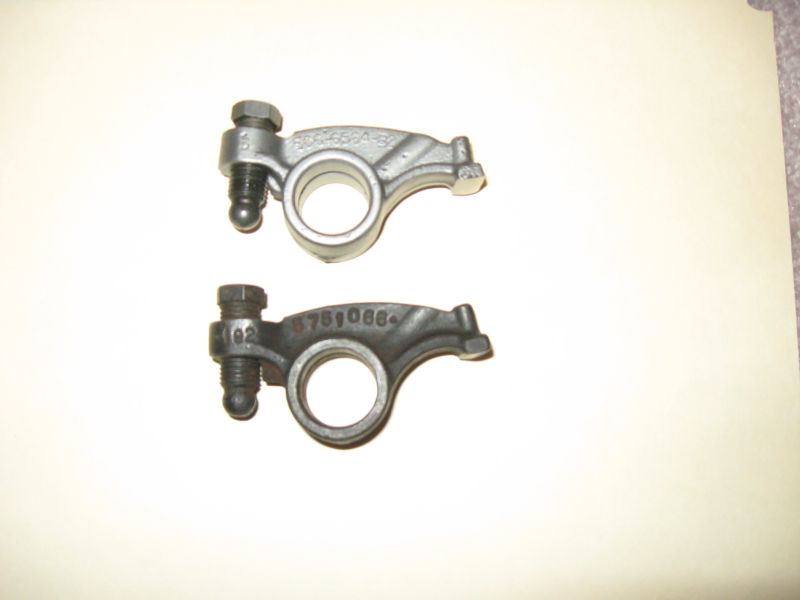|
By CK - 11 Years Ago
|
My rocker is confusing me
Thought I'd poise on that.
Well it looks like it's marked as an EAN which is 1.43
Yet it's got numbers 6564
However being the head and deck have had about .100" taken off them the adjuster is pretty much in the middle of its adjustment.
This makes the valve arm 1.5360" from the centre axis. Now this is how I interpret the pushrod arm axis, to the centre of the ball. And it's length is .8660"
So when I divide 1.5360 x .8660 I get 1.774:1 ratio
What am I doing wrong?

|
|
By chiggerfarmer - 11 Years Ago
|
|
I cannot help with your math but for what it's worth, the 6564 is merely the base catalog part number for all rockers. The EAN tells you which of the 6564 rockers it is.
|
|
By charliemccraney - 11 Years Ago
|
You can't know precisely how it contacts the valve and pushrod and I imagine that is where the error is coming from. The correct way to check is to measure pushrod movement and valve movement and use those figures to determine the ratio. This probably won't return the published ratios either but it will tell you what the rocker ratio actually is.
|
|
By PF Arcand - 11 Years Ago
|
I'm not sure about the math involved either. However, those rockers are 1:43 nominal ratio. John Mummert wrote a blurb on this subject,quite some time ago in Y-Block magazine, but I doubt I can find it now. Maybe someone out there remembers?..
|
|
By Riz - 11 Years Ago
|
I could be way off and this could be a stupid comment, but I always understood the ratio of the rocker to be the differential of the imput-pushrods for how far it pushes down across the fulcrum on the valve. So the pushrod pushes up 1 unit and pushes down 1.49.
From my understanding from what you are describing with the lowered deck you have changed the lift of the pushrod (in essence lengthened the pushrod with a shorter deck)
It would be more akin to a different lift or larger lobe on a cam swap.
I don't think it would change the rocker ratio, but might affect the overall lift or increase the opening of the valves.
Or that is a guess and I am a noob-either would be accurate, and I will defer to one of the guru engine builders.
|
|
By charliemccraney - 11 Years Ago
|
|
Riz, you are correct. The position of the adjuster screw does affect the ratio. All the way in is a lower ratio. All the way out is a higher ratio. So everything else the same, milled heads or block will result in a higher ratio which affects the lift and duration at the valve..
But that's not what is going on here since it is only the rocker itself being measured.
|
|
By CK - 11 Years Ago
|
Perhaps it's actually the point of the ball at which the leverage is actuated. Or that the valve and pushrods are angled differently 16* and with the shaft positioning, the geometry is altered in some way.
I have now turned the engine with a dial indicator at the valve and I'm getting .420" which is what a 1.43:1 rocker would do being the cam has a lift of .293"
Has any one got one of each to sit side by side?
|
|
By lyonroad - 11 Years Ago
|
|
Here is a picture. 1.54:1 above 1.43:1 below. You can see that the ball on the adjuster screw for the 1.54 is much closer to the rocker body than the 1.43. You can use a drill bit to measure the gap. 1/4" for the 1.54 and 11/32" for the 1.43. If the 11/32" bit won't fit its a 1.54:1 rocker.

|
|
By CK - 11 Years Ago
|
I measured the rocker again, yet this time at the tip of the ball and this gives a ratio of 1.43:1.
Thanks for the help guys.
|
|
By CK - 11 Years Ago
|
Hey guys.
If you haven't read it you should.
http://www.enginebuildermag.com/2009/11/performance-rocker-arm-shaft-systems-time-tested-technology-provides-proven-performance/
|
|
By Jimz Bird - 11 Years Ago
|
Interesting article.
One thing did stick out to me.
"Also, make sure to select the proper length pushrods. Although the adjusters will allow a shorter than optimum pushrod length, Comp Cams recommends that the pushrods are the last component selected. Use an adjustable “checking” pushrod to determine the proper length. Start with the seat all the way in the body. Then turn the pushrod adjuster out one half to one full turn from bottom for maximum strength."
The Pros probably do something like this as a matter of course when building.
With the mishmash of parts that may have been used over the years I had the thought that maybe it would be worth the 15 bucks to get a pushrod checker to see if the proper length pushrods are currently installed and match.
Does that sound like a worthwhile project or not? If so, does the one half to one full turn sound correct?
Thanks for any input.
|
|
By Ted - 11 Years Ago
|
Jimz Bird (8/1/2014)
Interesting article. ... One thing did stick out to me."Also, make sure to select the proper length pushrods. Although the adjusters will allow a shorter than optimum pushrod length, Comp Cams recommends that the pushrods are the last component selected. Use an adjustable “checking” pushrod to determine the proper length. Start with the seat all the way in the body. Then turn the pushrod adjuster out one half to one full turn from bottom for maximum strength." Does that sound like a worthwhile project or not? If so, does the one half to one full turn sound correct?
Thanks for any input.
I’ll have to disagree with Comp’s blanket statement on having the adjuster all the way down and then backing it up 1½ turns. From their comment on ‘maximum strength’, then one can assume that the shorter the pushrod, the stronger the pushrod will be by lieu of less deflection length which of course would be correct. But their adjuster positioning simply doesn’t work for every style of rocker arm out there as the pivot point at the pushrod is just as important as the pivot point at the valve stem. Their statement might apply to their own brand of rocker arms but does not cover some of the other manufacturers out there.
Besides the geometry considerations of the pushrod at the adjuster, the adjuster position on many shaft mounted rockers will dictate the actual rocker arm ratio. Here’s the link to the article that was published several years ago in the Y-Block Magazine covering this in more detail and especially for the Ford Y-Block family of engines.
http://www.eatonbalancing.com/blog/2007/12/10/altering-rocker-arm-ratio-by-varying-the-length-of-the-pushrods/
And here’s the link to the article also published in the Y-Block Magazine during the same time frame that covered the rocker arm geometry itself.
http://www.eatonbalancing.com/blog/2007/12/10/rocker-arm-geometry/
|
|
By Jimz Bird - 11 Years Ago
|
Great stuff. That really helps.
Thanks Ted.
|
|
By lyonroad - 11 Years Ago
|
One thing that occurred to me the other night when it was too hot to sleep is that if you change the rocker ratio you change the angle between the push rod and the rocker and the push rod and lifter by a small amount. Perhaps from an optimum angle to a less than optimum angle. Has anyone ever thought of modified rocker stands that relocate the rocker shaft to the optimum location for a given set of rockers? Perhaps after market rocker producer have already thought of this and then again perhaps this is a hair brained notion given my lack of experience in all of this.
|
|
By charliemccraney - 11 Years Ago
|
|
lyonroad (8/2/2014)
...Has anyone ever thought of modified rocker stands that relocate the rocker shaft to the optimum location for a given set of rockers? Perhaps after market rocker producer have already thought of this and then again perhaps this is a hair brained notion given my lack of experience in all of this.
Yes. Usually height needs to be added to the stands and this can be done with spacers. Depending on the design of the shafts, you may be able to simply use flat washers or you may need to make spacers. For a Y, I think you want to make a spacer at least for the oil supply stand.
Regarding the pushrods, I don't think there is a whole lot of choice, you just use what needs to be used. On a Y, a longer pushrod results in a higher rocker ratio, everything else the same. I'm sure there is an optimum pushrod geometry but it will probably involve a fair amount of expense to achieve for minimal gain. It could be absolutely prohibitively expensive. I don't know how everything lines up there.
Here's a link getting into the subject of rocker geometry.
|
|
By lyonroad - 11 Years Ago
|
Thanks Charlie. I was initially thinking that the location of the shaft could be relocated laterally but I can see now how a vertical adjustment would achieve the same purpose.
|
|
By DryLakesRacer - 11 Years Ago
|
|
As a guy who designed and had roller rockers made I feel I need to chime in (both shaft and tip). I did it because I was wearing out valve guides on my racing engine which there were no manufactured roller tip rockers available. In a stock engine at least into the 90's there was no need by the auto manufacturers to do anything but what they did for years: they worked, they wore out parts, mileage wasn't a big concern.
Our Y-block rockers "rub" the valve stem down; if the geometry is not correct the "rub" pushes the valve sideways. As Ted says when you make a change like a resurfacing a block or head you need to look at the geometry again. The drawings are correct, whether you are using roller tips or stock tips. If you take a substantial amount off you need to look at the rocker stand to get the geometry back to normal. I've even used lash caps to do this. Stock engines run better and smoother when all aspects of the engine are examined during assembly. Time in assembly adds to longevity. Good Luck
|